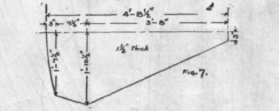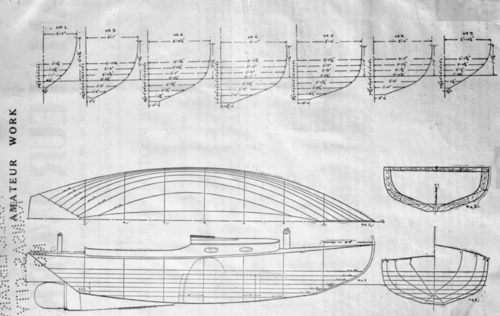A Twenty Five Foot Auxiliary Yawl. I. General Description and Lines
Description
This section is from the book "Amateur Work Magazine Vol6". Also available from Amazon: Amateur Work.
A Twenty Five Foot Auxiliary Yawl. I. General Description and Lines
CARL H. CLARK
This boat is designed as a general knockabout boat for (sailing, and also to offer fair cruising accommodations for two to four persons. 'I he yawl rig makes her very easy to handle, and the auxiliary power allows her to be bandied in calm weather or light head winds. The general design shows a boat witb somewhat of a dory model, with a large standing room and a fair sized cabin. The engine is located in the middle of the standing loom.
the model is somewhat similar to that of the regulation dory, but is Wider and deeper. the dory model gives the best boat for the least work that it is possible to obtain, the single plank bottom and flat stern making the work of construction very simple. The model also i«, from the nature of it, a very able one, with good sea-going qualities. 'Ihe moderate beam makes it easy to drive, thus requiring small sail power and allowing a good speed under engine power. A boat of this type has been found to be exceedingly satisfa tory for general sailing and short cruises. The auxiliary feature adds very greatly to the usefulness of the boat, as one may have all the plea-uresof sailing and still be leheved of the uncertainty from lack of wind.

While the model has many of the dory features, the laps of the dory have, however, been dispensed with and the smooth seam construction used instead, as it to more durable and more yachty in appearance.
The yawl rig is titled and she should be readily handled by one man in almost any kind of weather. The engine, also, is of a size to give her a fair rate of speed under power alone.
The cabin is arranged with a wide transom on each side of the centerhoard trunk, and cooking and toilet arrangements forward, allowing two or even four people 10 cruise in comfort.
This boat is so simple to build that there is no reason why it should not be undertaken by any one having the ability to properly use carpenter's tools.

Figs. 1-2 3, show the ordinary drawing of the lines, which is put in to give a general idea of the shape of the boat and to aid in laying it out on the floor. It will hardly be necessary to lay out the enthe boat on the Moor, as the detailed measurements of the moulds are given in Fig. 4. These moulds should however, be each carefully laid out lull size on a smooth door or large piece of paper. The dimensions given are to the exact size of the moulds, the thickness of the plank having already been deducted. A mould, or form, must now be made to the shape of each mould. The method of construction of the moulds is as shown in Fig 5; any rough stock may be used, but they must be ac urate to shape. The center line should bemaik-ed on both 1ower and upper cross pieces for use it setting up. Fig (J shows the outline of the stem with all necessary dimensions for laying it out. The stern board is also shown in Fig. 7, one side only being shown ; this ran, of ceuise, be easily duplicated for the other side, paper patterns of both should be made. the actual construction work will be begun in the next chapter.

Lines And Mould Dimensions Of Twefty Five Foot Yawl
Continue to:


